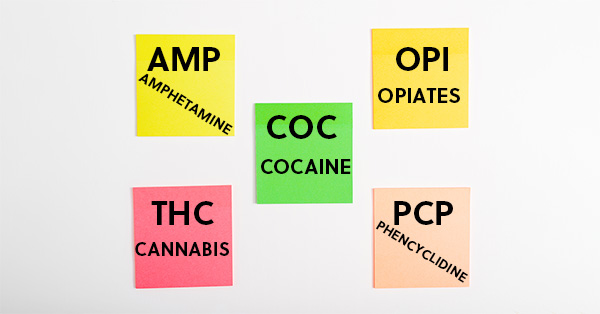
Drug Testing at Work: Why It Matters for Small to Medium Business Owners
Drug use in the workplace is a real issue that many small to medium business (SMB) owners face. According to National Survey on Drug Use

What Is on a 12 Panel Drug Test?
Just here for the 12 most commonly tested substances?
If you prefer to skip the article, view the substances below.
UPDATED: 12/13/2023
Many people would like to know what is on a 12-panel drug test. Employers need to learn what substances they are testing for. Potential employees would like to know what they are being tested for. Other individuals have their own reasons to inquire into the matter. If a drug test is said to screen for the most common substances, what might those substances be? At DrugTestKitUSA, we believe in providing information for all, and would like to answer this question for our audience.
First of all, let’s define “panel”. A drug “panel” refers to the specific drug, or drug family, that one would want to test. The panel number corresponds to the number of drugs or drug classes tested. Companies manufacture a variety of panels, which mostly range from 5 to 14 drug tests. There are more comprehensive panels, which include 16, 18, 20, 22 and even 25 drug types, but they are rare. The most common panels are 5-, 10-, and 12- panel screens. Companies will have different panel options. Any number of panels is fair game, but most drug testing will stay within the common range. As panel number goes up, usually the cost per test will decrease.
Now that we understand that panels denote the amount of drug types/classes on the test, we can talk about the different drugs that the tests screen for. The test kits with more panels usually have expanded opiates and specialty panels, or drug and alcohol combinations.
While common drug tests contain Opiates (OPI) as an overall opioid family detection, expanded opiates configurations might detect different types of opiates, such as synthetic Oxycodone (OXY) and Methadone (MTD). Even though these two synthetic substances are in the opioid family, they may not show up on a test with Opiates (OPI) because they are synthetic. Thus, they may cross-react with OPI at a much higher concentration (depending on the specific antibodies used in the test).
Specialty tests may include more obscure drugs like Propoxyphene (PPX) and Tricyclic Antidepressants (TCA).

Originally, the NIDA-5 (later SAMHSA-5) test was the standard for testing. It included:
– Amphetamine (AMP)
– Cocaine (COC)
– Opiates (OPI)
– Marijuana (THC)
– Phencyclidine (PCP)
(Cavacuiti, Christopher A.).
The detection window for these substances is similar. Amphetamines can last for 2 days, Cocaine stays in the system for 2-3 days, Opiates last from 1-3 days. It is Marijuana (THC) that stays the longest by far; its detection window could be anywhere from 3 to 30 days, and possibly longer for chronic users and individuals with higher body fat.
There are variations of the 5-panel drug test which have Methamphetamine (mAMP or MET), Benzodiazepines (BZO) and others.
“Wait“, you may be thinking. “I just wanted to know what shows up in a 12-panel drug test. Why are we discussing the 5-panel instead?”
The reason is, the basic 5-panel urine drug test is the most common and affordable drug test. These 5 main drugs: Amphetamine (AMP), Cocaine (COC), Opiates (OPI), Marijuana (THC), and Phencyclidine (PCP) are usually the common configuration for the 5-panel. 12-panel drug tests usually start with these standard substances as a base. This gives the drug test room for many more options. While the 5-panel can be quite varied, of course, the 12-panel can have many other configurations.
The 12-panel will most likely start out with the same drugs that a 5-panel typically tests for: Amphetamine (AMP), Cocaine (COC), Opiates (OPI), Marijuana (THC), and Phencyclidine (PCP). That takes care of 5/12 substances. In addition to these, the 12-panel is normally able to detect Barbituates (BAR), Benzodiazepines (BZO) and Methamphetamine (mAMP or MET). These are the 3 other drugs that the 5-panel will rotate when it doesn’t stick to the 5 standard substances.
The cut-off chosen for opiates is often different based on the setting. For instance, Drug Treatment and Emergency departments often use 300 ng/mL, a lower cut-off for opiates, while workplace and other settings use 2000 ng/mL, a higher cut-off for opiates. This opiate component will vary based on the target population tested.
The 12-panel offers more opportunities for different drug combinations. Due to the current opiate epidemic in the United States, it makes sense to expand the opiate section of the test. The 12-panel will often differentiate between natural opiates (300 ng/mL or 2000 ng/mL cutoffs) and synthetic opioids like Methadone (MTD), Oxycodone (OXY), Buprenorphine (BUP) or Propoxyphene (PPX). Usually, Opiates (OPI) or Morphine (MOP) are listed along with their cut-offs. Some manufacturers use MOP and others use OPI, while others designate one for the 300 cutoff and another for the 2000 cut-off.
Methadone (MTD) and Buprenorphine (BUP) are used for treatment of opiate abuse, but can also be abused themselves. Depending on the setting and the individual, you may want the patient to be positive or negative for these drugs.
Other options for the 12-panel include Ecstasy (MDMA) aka Methylenedioxymeth-amphetamine and Tricyclic Antidepressants (TCA).

To recap, let’s list what substances are most used in the 12-panel drug test. Almost certainly, you will encounter the following:
1) Amphetamine (AMP)
2) Cocaine (COC)
3) Marijuana (THC)
4) Phencyclidine (PCP)
5) Methamphetamine (mAMP or MET)
6) Barbiturates (BAR)
7) Benzodiazepines (BZO)
8) Buprenorphine (BUP)
9) Methadone (MTD)
10) Oxycodone (OXY)
11) Morphine (MOP)
12) Ecstasy (MDMA)
The 12-Panel Drug Test Cup from DrugTestKitUSA has these exact configurations. In other 12-panel drug tests, Buprenorphine (BUP) may be substituted by Propoxyphene (PPX) or Tricyclic Antidepressants (TCA).
This isn’t an exhaustive list of substances used for drug testing. Many manufacturers are creating tests that correspond with emerging street drugs that are gaining popularity, such as Fentanyl (FEN), GHB, A-PHP and others. The specific drugs included in 12-panel drug tests will continue to evolve. When you are considering a drug test for your facility, a 12-panel is usually the best option. It is economical and allows for the selection of the best combination of drug tests for your specific setting.
Cavacuiti, Christopher A., Principles of Addiction Medicine: The Essentials. N.p., Wolters Kluwer Health, 2012.

Drug use in the workplace is a real issue that many small to medium business (SMB) owners face. According to National Survey on Drug Use

The AvertD test is a prescription-only genetic test for those 18+ to assess the risk of opioid use disorder using a cheek swab.


Security at Stripe: Learn how Stripe handles security.
A PCI-certified auditor has audited Stripe. We’re a certified PCI Service Provider Level 1. This is the most stringent level of certification available in the payments industry. To accomplish this, we use the best-in-class security tools and practices to maintain a high level of security at Stripe.
Stripe forces HTTPS for all services using TLS (SSL), including our public website and the Dashboard to ensure secure connections:
We regularly audit the details of our implementation, including the certificates we serve, the certificate authorities we use, and the ciphers we support. We use HSTS to ensure that browsers interact with Stripe only over HTTPS. Stripe is also on the HSTS preloaded lists for both Google Chrome and Mozilla Firefox.
All card numbers are encrypted at rest with AES-256. Decryption keys are stored on separate machines. None of Stripe’s internal servers and daemons can obtain plain text card numbers but can request that cards are sent to a service provider on a static allowlist. Stripe’s infrastructure for storing, decrypting, and transmitting card numbers runs in a separate hosting environment, and doesn’t share any credentials with Stripe’s primary services including our API and website.
Why use PayPal?
Your information is secured.
When you pay with PayPal, your financial information is never shared with the seller, and you can pay using only your email address and password.
Security around the clock.
PayPal monitors every transaction 24/7 to help prevent against fraud, email phishing and identity theft. Every transaction is heavily guarded behind their next-level encryption.
If something seems suspicious, their dedicated team of security specialists is immediately on it to help protect you from fraudulent transactions. And remember, PayPal will never ask for any sensitive information from you in an email.
You can be sure that your transaction is protected and secure when you use PayPal at the DrugTestKitUSA checkout.